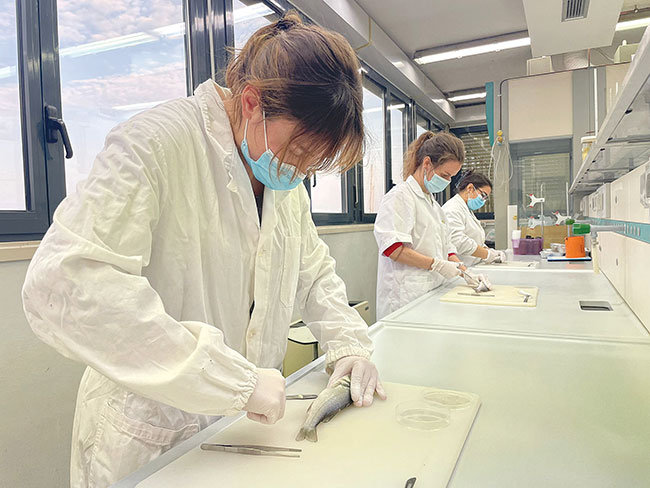
Features
High fishmeal-fish oil dietary levels may help European sea bass juvenile fight stress
April 25, 2022 By Ruby Gonzalez
 The University of Bologna team during experimental sampling
Credit: Nicole Francesca Pelusio
The University of Bologna team during experimental sampling
Credit: Nicole Francesca Pelusio Low fishmeal(FM) to fish oil (FO) ratio in European sea bass juvenile diet may not only affect stress levels but the bottom line, too.
Fish on 10 per cent FM and three percent FO diet, the lowest dose among the dietary levels in a study conducted in Italy showed lower final body weight, weight gain, and specific growth rate compared to the other treatments at the end of the 60-day feeding trial. The moderate reduction in growth performance in the low-level group seemed to be related to the higher feed conversion ratio in its diet.
A study, “Different Fish Meal and Fish Oil Dietary Levels in European Sea Bass: Welfare Implications After Acute Confinement Stress,” sought to provide practical feed management guidelines preceding a stressful episode during farming practices.
Intermediate level group had 20 per cent FM and seven per cent FO and high, 30 per cent FM and 15 per cent FO.
Fish in high-level group indicated better response. “Though the stress exposure caused some systemic physiological alterations in some tissues of fish fed higher FM and FO content, a prompt started to produce some anti-inflammatory molecules as attempt to counteract the stress,” corresponding author, Nicole Francesca Pelusio, explained to Hatchery International. She is a PhD candidate at the University of Bologna.
Feed formulations for European sea bass with very low contents of FM and FO have demonstrated their potentials for commercial use. Another aspect that should be considered though is the susceptibility of the species in to rearing, pre- and post-harvest stress-related factors commercial farm-scale environment. These could stem from handling, sorting fish size, harvest and transportation.
Stress in fish may be managed through procedures such identifying ideal stocking density, monitoring water for nitrate and ammonia levels and biosecurity measures.
Pelusio is an advocate of good feeding strategy. “I strongly believe that a good feeding strategy can contribute to boost and/or sustain fish robustness to stress exposure, matching animal welfare, product quality and famer profit,” she said.
Stress may result in chain reaction that affects the bottom line. “When fish experience a continuously prolonged or intense stress related to farming practices, as response they internally produce some compounds that in case of lack of coping the stress, they can get weaker and easily exposed to disease and in dramatic cases death might occur,” she pointed.
It doesn’t matter if the stress occurs near the tail-end of production, say prior to final harvest. She explained that these stress-induced compounds remain at high contents in the post-mortem body and induce chemical alterations that lead to quality alterations such as meat/fillet gaping, reduction of shelf-life and easiness to spoil faster.
“These facts cause a shorter shelf-life of final product with some and less appealing to consumers which can be translated in important economic losses for the whole chain,” she said.
The published work belongs to the European project, MedAID.
Print this page





